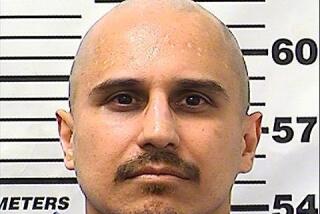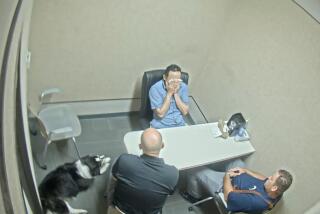Motorist Matching Knott’s Looks Seen With Trio, Jury Told
- Share via
Defense witnesses in the trial of former California Highway Patrol Officer Craig Peyer, who is accused of murdering a 20-year-old San Diego college student, raised new questions Friday about the time and circumstances of the woman’s death.
Defense attorney Robert Grimes called Wanda Dobbie, a nurse at Palomar Hospital in Escondido, who testified that late on Dec. 27, 1986, she saw a woman matching Cara Knott’s description struggling with three Latino men on the freeway shoulder.
Dobbie said that she was driving home from work, southbound on Interstate 15, at 11:25 p.m. when she saw the woman standing next to a light-colored Volkswagen beetle, kicking and fighting with one of the men. Dobbie said the woman had shoulder-length hair and was wearing a white shirt, dark pants and white footwear.
Knott, 20, was driving a white Volkswagen beetle and was wearing a white sweat shirt, purple sweat pants and white leather boots when she was killed.
“I saw the young girl standing by the Volkswagen . . . A male had her by the shoulders. She had something white on top and something white on her feet. She was kicking,” Dobbie said.
The Volkswagen was parked parallel to the freeway, said Dobbie, while a late-model Datsun was parked at an angle in front of it, blocking the Volkswagen. While the woman fought off one man, two other Latino males ran from the Datsun, Dobbie said.
North of the Spot
According to Dobbie, the incident took place at the Camino del Norte off-ramp of Interstate 15, about three miles north of the spot where Knott’s body and car were found at 8:12 a.m. on Dec. 28, 1986. While Dobbie said the incident happened at 11:25 p.m., prosecutors said that Knott was killed between 9 and 10 p.m. Dec. 27, 1986.
Two weeks ago a man and his girlfriend testified that on the night that Knott was killed they drove to the darkened Mercy Road area where they parked for about 45 minutes. The couple testified that at 9:45 p.m. they saw Knott’s empty car parked nearby, where it was later found by police.
Peyer, a 13-year CHP veteran, was arrested Jan. 15, 1987 and charged with killing Knott. Police said that she was strangled after a struggle on the old U.S. 395 bridge near Interstate 15 and the Mercy Road off-ramp in San Diego. Her body was thrown 65 feet into a dry creek bed, where it was discovered by police the next morning.
Since the trial began three weeks ago, prosecutors have called nearly two dozen young women who testified that Peyer stopped them at night on the isolated Mercy Road off-ramp in 1986. Some of the women said that they were stopped for minor traffic violations, such as faulty lights. Others said that Peyer stopped them for speeding but ended up giving them lesser “fix it” tickets.
All of the women said that the stops were lengthy, none lasting less than 20 minutes, and that at no time did Peyer ever touch them or ask them for dates. One of them, Cheryl Johnson, a pediatric nurse at the UCSD Medical Center, testified that Peyer detained her for an hour and 40 minutes when he stopped her at 8:30 p.m. on June 25, 1986.
Testimony Contradicted
Johnson said that she remembered the stop vividly because she was driving home from work after one of her patients had died. She called the ticket given to her by Peyer “the icing on my day.”
However, Carol Grogan, an administrator at UCSD Medical Center, testified Friday that Johnson did not work on June 25, 1986 and Martha Hopkins, acting director of records, said that there were no baby deaths on that day at the hospital.
On Thursday, several defense witnesses contradicted the damaging testimony of Robert Calderwood, who said that he saw a CHP cruiser stop a light-colored Volkswagen at the Mercy Road off-ramp on the night that Knott was killed. Calderwood, a milkman from Fallbrook, testified as a surprise witness last week.
But four of Calderwood’s co-workers testified for the defense and said that Calderwood had told them a different version of what he saw on Mercy Road and when he saw it.
Michelle Martin, another surprise prosecution witness, testified on Wednesday and identified Peyer as the CHP officer she said stopped a light-blue Volkswagen on Mercy Road on the night Knott was killed. She is the only witness to identify Peyer on Mercy Road on the night of the killing.
Martin is a former security guard and on Thursday her former boss testified for the defense and said she had a tendency to “fantasize” and added that she was fired for being lazy and for poor job performance.
Fiber Expert Testified
Friday’s list of witnesses included John Reffner, who testified as a fiber expert for the defense. Prosecutors have introduced six microscopic fibers as evidence that they say link Peyer to Knott’s killing.
Three of the fibers are purple. Prosecution witnesses said they were recovered from Peyer’s gun and left boot and added that they match fibers from Knott’s purple sweat pants. Reffner said that the dye in the fibers introduced by the prosecution does not match the dye in Knott’s sweat pants.
“There’s no correlation between the fibers . . . on the boot or the gun,” Reffner said.
But under sharp questioning by Deputy Dist. Atty. Jim Atkins, Reffner agreed that two incriminating dark-blue fibers found in each of Knott’s hands are “consistent” with similar fibers taken from the CHP patches on Peyer’s jacket.
“They’re consistent. But I can’t say they’re the same or a match,” Reffner said.
Reffner is a consultant to the Connecticut State Police and worked at the same Illinois laboratory that supplied the prosecution’s fiber expert. He said that he had “high regard” for the work done by the Illinois lab.
Three weeks ago San Diego Police Officer Jill Ogilvie testified about a lengthy conversation she claimed to have had with Peyer on Dec. 31, 1986 at Mercy Road. According to Ogilvie, Peyer questioned her relentlessly about the homicide investigation into Knott’s death and repeatedly asked her for the “real scoop.”
Ogilvie testified that Peyer suggested that Knott’s death could have been an “accident” or “a situation that got out of control,” and said that he appeared very agitated and excited.
On Friday, Officer Elsa Sandez, who is Ogilvie’s former partner, testified that Ogilvie’s conversation with Peyer was much shorter and she did not notice anything unusual about Peyer’s demeanor. Grimes produced a police report where Sandez is quoted as saying that Peyer spoke with Ogilvie for only one or two minutes before leaving the scene.
Sandez said that she had provided cover for Peyer on two previous occasions. Ogilvie and Sandez had responded to Mercy Road when Peyer requested back up. While Ogilvie talked to Peyer, Sandez said she interrogated three or four individuals.
“He (Peyer) did not seem any different from other times that I had talked to him. He was very talkative and a real bubbly person,” Sandez said.
CHP Officer Richard La Lima testified that Peyer was a friendly and outgoing officer who liked to talk to motorists. La Lima said that his traffic stops averaged between 10 and 15 minutes but Peyer’s stops were routinely longer.
“He was just a little friendlier than I was,” La Lima said.
La Lima added that like Peyer, he too frequently stopped motorists at the Mercy Road off-ramp at night. He supported defense claims that it is not unusual for CHP officers to order a motorist to an off-ramp after stopping him on the freeway.
“If I was in the area of an off-ramp I would direct them to the off-ramp, using the public address system,” said La Lima. “ . . . It was just safer to stop in the middle (of Mercy Road).”
Peyer, 37, is only the second CHP officer ever charged with committing murder while on duty. He was fired in May and is currently free on $1 million bail.
The defense is expected to rest its case by Monday or Tuesday. On Monday afternoon the jury is scheduled to visit the murder scene.
More to Read
Sign up for Essential California
The most important California stories and recommendations in your inbox every morning.
You may occasionally receive promotional content from the Los Angeles Times.













